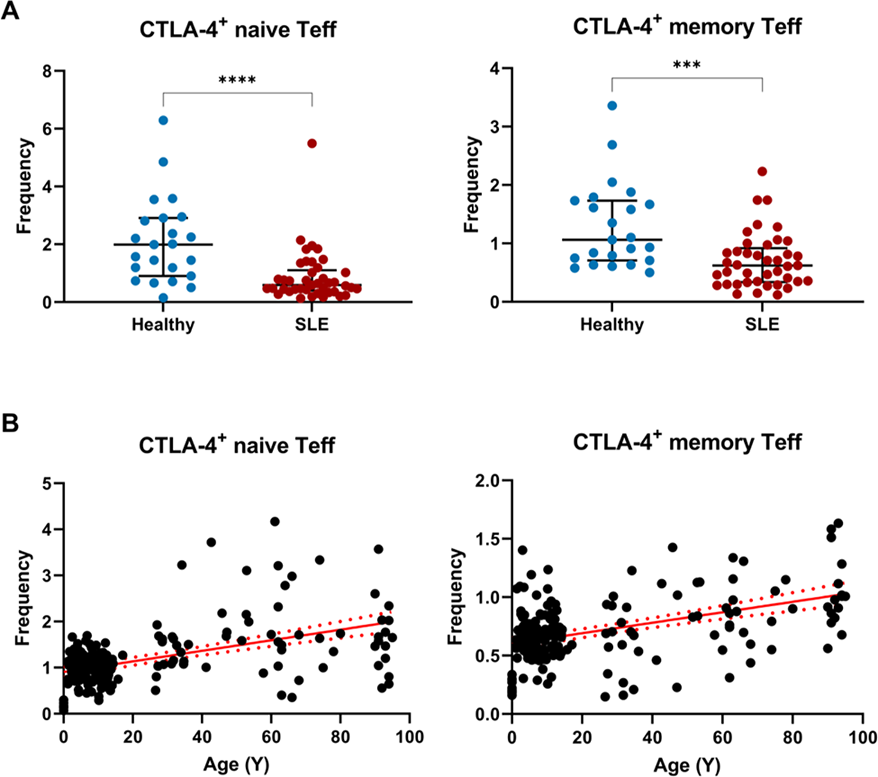

Background: Cytotoxic T lymphocyte-associated protein 4 (CTLA-4) is a crucial immune checkpoint inhibitor expressed on CD4 + Foxp3 + CD25 + regulatory T cells (Tregs), essential for maintaining immune homeostasis and preventing auto-reactivity. Interestingly, CTLA-4 is also expressed on CD4 + Foxp3 - CD25 - non-Treg effector T cells (Teffs). We observed a significant reduction in CTLA-4 expressing Teffs in adult lupus compared to age-matched healthy controls, suggesting a putative role of CTLA-4 on Teffs in maintaining immune homeostasis. Thus, we hypothesise that an increase in CTLA-4 expression in Teffs is a natural phenomenon and is biologically necessary to maintain immune homeostasis with increasing age to counteract our increased exposure to exogenous immune stimuli.
Objectives: To characterize CTLA-4 expression on Teffs in adult lupus versus healthy adults and determine the correlation of age with CTLA-4 expression using a healthy dataset.
Methods: To achieve this, we examined mass cytometry data from peripheral blood mononuclear cells (PBMCs) from adult lupus patients (n=26) and their age-matched healthy controls (n=23). The SLE patients (23 females) had a median age of 40 (interquartile range [IQR]: 28 to 54) years with a median SLEDAI 2K score of 4 (IQR: 0 to 6). Batch effect correction, clustering, and annotation of cell subsets based on marker expression were performed using our Extended Polydimensional Immunome Characterization (EPIC) pipeline. 1 We compared the CTLA-4 expression on both naive and memory Teffs between the SLE patients and healthy controls. To depict the age-related CTLA-4 expression gradient, we re-mined the mass cytometry data from PBMCs from 193 healthy individuals (0 to 95 years old) from the EPIC database. 1 Frequencies are expressed as a percentage of total CD45 + PBMC or ratio and described with median and IQR. Statistical significance is defined as p<0.05 (Mann-Whitney U test). For the correlation analysis, statistical significance is defined as p<0.05 (Spearman correlation with 95% confidence interval).
Results: The frequencies of both naive (CD45RA + ) and memory (CD45RO + ) CTLA-4 + CD25 - Foxp3 - Teffs were significantly decreased in adult lupus relative to age-matched healthy controls (p<0.0001 and p<0.001 respectively, Figure 1A). Interestingly, no differences in the frequencies of both naive (p = 0.6492) and memory (p = 0.8107) natural Tregs (CTLA-4 + CD25 + Foxp3 + ) were seen between adult lupus and healthy controls.
When the EPIC healthy dataset was examined, expectedly, the frequency of CTLA-4 + naive Tregs correlated negatively with age (Spearman correlation, r = -0.6497, p<0.0001) while memory Tregs correlated positively with age (r = 0.6609, p<0.0001). Interestingly, both naive and memory CTLA-4 + Teffs frequency increased with age (r = 0.3837, p<0.0001; r = 0.4533, p<0.0001 respectively, Figure 1B). CTLA-4 + Teffs significantly differed between the 0-6 and 6-12 versus 40-60 and 60-95 year-old age groups (Kruskal-Wallis test; Dunn’s multiple comparison tests, p<0.0001).
Conclusion: Our results suggest that CTLA-4 expression on Teffs increases naturally with age and may be needed to maintain immune homeostasis. Its reduction in adult lupus patients may contribute to the loss of peripheral tolerance by reducing the cellular activation threshold to stimuli resulting in autoimmunity. Conversely, we postulate that if it is increased abnormally, it may contribute to immunosenescence, resulting in increased susceptibility to infection and reduced vaccination responses in the elderly. Further mechanistic studies will be needed to delineate the immune rheostat role of CTLA-4 in setting the activation threshold for Teffs.
REFERENCES: [1] Yeo JG et al. Nat Biotechnol. 2020 Jun;38(6):679-684.
(A ) Frequency of CTLA-4 + naive and memory Teffs in adult lupus patients (n=41 time-points) versus age-matched healthy controls (n=23). IQR and median annotated, Mann-Whitney U test, **** p<0.0001. (B ) Correlation of frequency of CTLA-4 + naive and memory Teffs with age; positive correlation with age was observed in both naive and memory Teff subsets. Spearman’s correlation with 95% confidence interval shown.

Acknowledgements: NIL.
Disclosure of Interests: None declared.